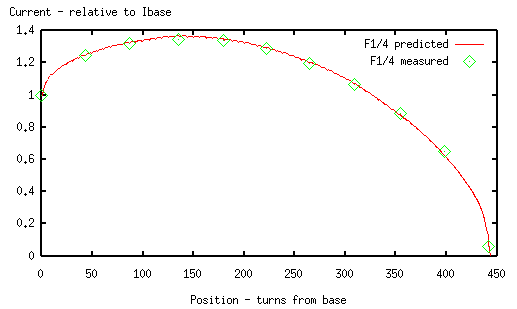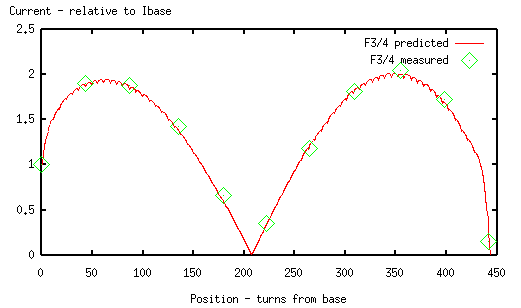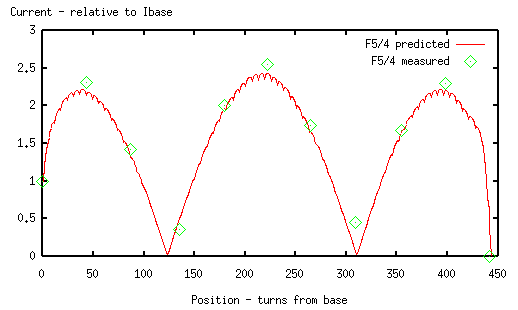| TSSP: Current Profile Measurement |
The availability of a high precision Q measurement technique
(tcma) enables the current profile of a Tesla secondary to be accurately
determined by means of a resistance insertion method.
Updated: 19 Jul 2008
A coil is fitted with series taps such that each tap can be closed by a link, or by a small resistance, as shown below.

In this example the coil winding is broken into ten roughly equal sections, giving eleven tapping points numbered 0..10 from the base.
A resistance is inserted into each tap, one at a time, and the resulting Q measured for each of the eleven taps. An additional Q measurement is
taken with no resistance inserted. The current profile can then be calculated from the resulting set of twelve Q measurements.
This method does not
require knowledge of the resistor value, or the resonant frequencies. No voltage or current measurements are required.
The calculation proceeds as follows:
For the ringdown, for each frequency component,
Eloss/Es = 2 pi / Q
where Eloss is energy lost per cycle and Es is the stored energy,
(both functions of time).
Consider Eloss to be the sum of the energy lost in the coil (Ec)
plus the energy lost in the extra series resistance (Ex). Then we
can say
Ec/Es = 2*pi/Qs ...(1)
where Qs is the Q measured without the extra resistor. With the
resistor added at point x = 0..10 in the coil, we have
(Ec + Ex)/Es = 2*pi/Qx ...(2)
where Qx is the associated observed Q. We have 11 of these
equations.
Substituting (1) into (2) gives
Ex/Es = 2*pi/(1/Qx - 1/Qs) ...(3)
Now at any cycle of the ringdown,
Es = Lee * Ib^2/2
where Ib is the peak base current, and the 11 equations
Ex = R * Ix^2/(2*f) x = 0..10
in which Ix is the peak current at the resistor point x,
With these, (3) becomes
Ix^2/Ib^2 = 2*pi*f*Lee/R * (1/Qx - 1/Qs)
which is independent of time now that we have eliminated all the
energy terms. Noting that Ib = Ix when x = 0, we have
1 = 2*pi*f*Lee/R * (1/Q0 - 1/Qs)
and the other ten equations
Ix^2/Ib^2 = 2*pi*f*Lee/R * (1/Qx - 1/Qs) ; x = 2..10
The first equation gives
2*pi*f*Lee/R = Q1 * Qs/(Qs - Q0)
and using this to eliminate all the unknowns in the remaining
ten equations gives
Ix^2/Ib^2 = (1/Qx - 1/Qs) * Q0 * Qs/(Qs - Q0) ; x = 1..10
Therefore eleven Q measurements Q0 to Q10, one for each link, plus an extra one Qs of the coil
without the resistor, can be used to determine the current
profile Ix/Ib through the formula
Ix/Ib = 1 ; x = 0
Ix/Ib = sqrt{ (Qs - Qx)/(Qs - Q0) * Q0/Qx } ; x = 1..10
It can be seen from the above equation that the resulting current profiles are quite sensitive to the difference between measured Q values.
Therefore, for this method to be successful, high precision Q measurements are necessary.
Purpose
(a) To determine whether computer analysis of base current ringdown waveforms provides a sufficiently accurate method for determining current
profiles.
and
(b) To confirm the predicted current profile for the coil, and to
demonstrate the elevated current maximum in a resonating solenoid, as shown in fig 6.1 of
pn2511.
Test Coil
Terry Fritz has constructed a test coil for this experiment,
Test Coil.
This coil has a h/d ratio of 0.9, which is ideal for demonstrating
the current maximum induced through the internal capacitance of the coil.
The tssp model produces the following predictions for the coil
Measured Modeled Error
f1/4 229.9 kHz 229.3 kHz -0.3%
f3/4 578.1 kHz 570.4 kHz -1.3%
f5/4 904.1 kHz 908.9 kHz +0.5%
Ldc 39.0 mH 39.18 mH +0.5%
Rdc 32.65 ohms 32.91 ohms +0.8%
The modeling program is making a rough compensation for the coil former dielectric in the above figures. The frequency match is
good on the first three resonant modes, which is enough to indicate that the model is correctly set up.
Therefore we expect a good match on the current profiles.
Measurements
By using an inserted resistance of 100 ohms, with Q measurements made by base current waveform capture and analysis by
tcma, the following set of Q readings were obtained, shown along
with their calculated Ix/Ib values:
Turn Measurement Q1/4 Ix/Ib Q3/4 Ix/Ib Q5/4 Ix/Ib
0 Q0 TEK00001 283.73 1.000 167.37 1.000 102.28 1.000
43 Q1 TEK00002 234.04 1.243 134.53 1.907 87.25 2.308
87 Q2 TEK00003 219.97 1.320 135.33 1.886 98.32 1.418
135 Q3 TEK00004 215.22 1.347 152.51 1.432 105.97 0.354
179 Q4 TEK00005 216.63 1.339 176.59 0.661 91.38 1.999
222 Q5 TEK00006 225.62 1.288 182.10 0.356 83.81 2.557
265 Q6 TEK00007 242.45 1.198 161.33 1.185 94.60 1.743
309 Q7 TEK00008 268.92 1.068 138.21 1.810 105.66 0.443
354 Q8 TEK00009 309.45 0.887 129.02 2.051 95.48 1.670
398 Q9 TEK00010 366.75 0.648 141.24 1.731 87.35 2.301
442 Q10 TEK00011 464.28 0.060 184.04 0.149 107.05 0.000
along with the unloaded reading
Qs TEK00000 465.35 184.46 106.52
The detailed tcma output results from which these results are summarised, can be seen
in tcma-output.txt. Raw data CSV files, and pictures of the
experiment can be seen
here. The measurement run only took a few
minutes, so we make no attempt to compensate for the negligible temperature variation.
Results
When plotted against the predicted current profile for each resonant mode, we obtain
 1/4 wave
1/4 wave
 3/4 wave
3/4 wave
We see good agreement on the 1/4 wave mode, and a reasonably good match with the 3/4 wave.
The 5/4 wave mode below is showing some significant errors, of up to 10%.
 5/4 wave
5/4 wave
Note: The ripple effect on the predicted current profiles is an artifact of the coil modeling software. It is caused by
the interpolation method which deals with the limited spatial resolution of the internal capacitance. The particular
method used has good global accuracy at the expense of some local aliasing noise, which appears as the ripple.
This turns out to be quite convenient in practice, because you can see at a glance those parts of the current profile
which are being strongly affected by internal capacitance.
(a) Q Measurements
The Q determination appears to be sufficiently precise for accurate measurement of the current profiles of the
lowest resonant frequency. Errors of around 3% occur with the 3/4 wave profile, and around 10% with the 5/4 wave.
This is partly due to limitation of the modeling program, and partly due to sensitivity of the calculation to the
small differences between Q measurements, especially at low currents. For all three modes, the discrepancies
between measured and predicted current profiles are comfortably within the combined errors of the measurement and
modeling processes.
(b) Elevated Current Maximum
This feature of solenoid resonance,
which results from the effect of mutual capacitance between one part of the coil and another,
is one of the main departures from the kind of transmission line behaviour described by the familiar telegraphist's equation. The elevated
current maximum is clearly demonstrated in the 1/4 wave profile.
The experiment also gives us a clear demonstration that the ratio Les/Ldc can exceed unity, in this case by around 12%.
We can also extract a direct measurement of the equivalent energy storage inductance, Lee from the results as follows:
If Rin is the input resistance at resonance,
and R is the added series resistance, we have
Rin = 2 pi F Lee/Qs
and
Rin + R = 2 pi F Lee/Q0
Rearranging these and substituting to eliminate the unknown Rin, we obtain
Lee = Q0 Qs R / (Qs - Q0) / (2 pi F)
Using the measured values of R, Q0,
Qs, and F, we get
F R Q0 Qs Lee Meas Lee Model Error
f1/4 229900 100.57 283.73 465.35 50.6 mH 50.87 mH +0.5%
f3/4 578100 100.57 167.37 184.46 50.0 mH 49.98 mH 0.0%
f5/4 904100 100.57 102.28 106.52 45.5 mH 39.95 mH -12.2%
which confirms the predicted values of Lee at f1/4 and f3/4.
The error at f5/4 is due to the closeness of the two Q readings, each of which is subject to a few percent error. An accurate value
for Lee at this resonance would require re-measuring with a higher value of series resistance.
This experiment provides strong evidence that the modeling process is correctly quantifying the
internal capacitance of the coil, and that this capacitance is being properly applied in the solenoid model.
Maintainer Paul Nicholson, tssp0807@abelian.org.

 1/4 wave
1/4 wave 3/4 wave
3/4 wave 5/4 wave
5/4 wave